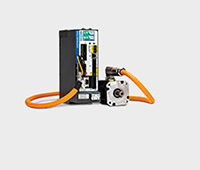Edited by Michael Jermann, Assistant Editor
Conroe Machine is hard turning a family of parts around the clock in an unmanned cell that operates a “self controlled” process. The turning cell integrates a Fanuc robot with the Equator gauging system, using Renishaw EZ-IO software to provide comprehensive communication for 100% part inspection and auto-compensation of a twin-spindle Okuma 2SP-250 lathe.

The robot chooses, through the Equator’s EZ-IO software, which measuring program to run for each type of part.
The company created an unmanned part measurement/sorting cell by combining two Equators, a Fanuc robot, a vision system and multiple lanes of low-profile conveyor. In both applications, the Equator demonstrates the value of programmable comparative inspection by quickly and cost effectively measuring a family of bearing races without fixturing or problems from a shop floor environment.
The bearings are currently roughed out on four Doosan Puma lathes that originally did both roughing and finishing, and were served by four operators. These machines were split into two cells, loaded/unloaded by Fanuc robots, doing only the roughing operation. The semi-finished parts are sent out to be case hardened to HRC 65 at a depth of 1.7 mm before the finish turning. Production plateaued at 800 to 1000 total parts per day with two cells and a single operator loading the machines and inspecting the parts.
Inspection must be fast to keep up with the cycle times on the parts, which can be as short as 98 seconds. Originally, the company looked at white light laser inspection because of its speed, but the parts were too reflective. They also looked at hard gauging and shop-floor CMMs. Hard gauging was very expensive and required setup attention, and the CMM gave no speed advantage.
The Equator uses the comparison method of measuring. A master part with known measurements taken on a CMM is used to “master” the Equator, with all subsequent measurements compared to the master. Repeatability is 0.002 mm immediately after mastering. To compensate for shop temperature changes, the Equator can be re-mastered at any time. The Equator uses an SP25 probe for touch and scanning data collection, at speeds of up to 1000 pps. Styli are stored in an integral six-port changing rack, and the system is programmed through MODUS Equator software. The Equator can be used manually with push-button ease, but its EZ-IO software for automation also allows it to be integrated into cells like Conroe’s.

The hard turning cell currently produces about 600-700 finished parts per day.
The company installed a cell consisting of the Okuma 2SP-250H, a single Equator, an engraving machine, and a Fanuc M20iA 6-axis robot. In practice, the lathe’s two part carousels are loaded with raw workpieces, approximately 300 parts. The lathe’s dual gantry loaders feed the spindles and place finished parts on a chute leading to a conveyor for pickup by the robot. The robot places the part on the Equator for measurement and if acceptable, transfers it to the engraving machine, and finally boxes/palletizes the finished parts.
Custom tool compensation software uses measuring results from the Equator, transmitted in the form of a CSV file, to offset the tools when the part deviates from tolerance. Machining removes about 0.38 mm from each side of the part, with the tightest tolerance at ±0.025 mm and a 0.5 µm surface finish. Parts range in size from about 3 to 6 in. OD. The OD/ID stays spot on, with perhaps a couple of tenths variation on radius. Parts are batch-processed by size, so changeovers of chuck jaws and other tooling are minimized.
Renishaw Inc.
www.renishaw.com
Filed Under: The Robot Report, MOTION CONTROL





Tell Us What You Think!